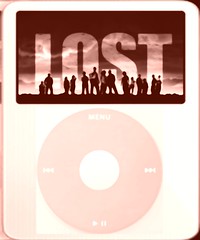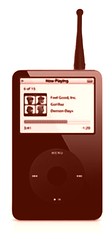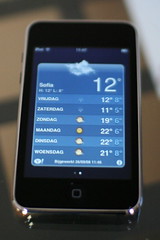iPod in 2009: more storage or bandwidth?
15 Aug 2006I had an interesting discussion some days ago: will the iPods move to more storage (e.g. the Terabyte iPod) or more bandwidth (Bluetooth, EDGE, Wifi). Let me sketch what those two scenarios for the future iPod look like:
2009 iPod as personal media storage
 That new iPod ‘3D’ might not be much bigger than the current 60GB iPod video, but it has a better 16:9 screen, and way more storage. It ships with a 500GB Flash card that is replaceable. You typically buy more storage cards: 1 for all your music, 1 for essential movies (with that Hitchcock and Tarantino collection), 1 for TV series (one season is around 15GB) and fill them up from your 50TB home media set-up.
That new iPod ‘3D’ might not be much bigger than the current 60GB iPod video, but it has a better 16:9 screen, and way more storage. It ships with a 500GB Flash card that is replaceable. You typically buy more storage cards: 1 for all your music, 1 for essential movies (with that Hitchcock and Tarantino collection), 1 for TV series (one season is around 15GB) and fill them up from your 50TB home media set-up.
The sleek white player has wireless USB and uses wireless battery reload (with magnetic holder) so you don’t need a cable for anything. Your 5.1 headphones: wireless. Copying from that 50TB iTunes/Tivo media station: wireless. Hooking it up to an HD-TV: wireless. Sure, it has Gigabit Wifi too (which is really only around 250Mbps, but we’re used to that from the 802.11 guys), but not everyone uses that yet, certainly not in that Ardennes village where you booked that small hotel for your “24” marathon (12 seasons, who would have thought? Thank god for the 2x hi-speed viewing mode).
It can obviously play the new “3HD” (3-dimensions) standard, which is really neat if you have one of those new holographic projectors. If you have subscribed to the (rather expensive) iTunes ‘Premium Hollywood’ service, you get all new movies on your iPod at the same moment when they are released in the cinemas. You only get them at consumer-grade HD resolution (2048×1080 – looks OK on that 50″ screen), not at the new DCI 8K standard for movie theatres (8192×4320 with HDR) but who’s complaining.
2009 iPod as personal media receiver
 While still not bigger that the current iPod nano, the new iPod ‘nanoo‘ packs 50GB of flash storage. Not that you know about it, because that’s just used as an temporary storage for what’s coming in over the air. As simple as its design might look, the device is packed with antennas: Gigabit Wimax and EDGE (it obviously doubles as a phone and PDA too) next to of course wireless USB and BluetoothXL.
While still not bigger that the current iPod nano, the new iPod ‘nanoo‘ packs 50GB of flash storage. Not that you know about it, because that’s just used as an temporary storage for what’s coming in over the air. As simple as its design might look, the device is packed with antennas: Gigabit Wimax and EDGE (it obviously doubles as a phone and PDA too) next to of course wireless USB and BluetoothXL.
Even when you’re not using it, it is always busy: as a VoIP node, as a BitTorrent node, as a P2P GPS traffic node, as a streaming audio/video node. The bandwidth providers just adore it. If the consumers do not want to be limited to usage in the municipal area, where most people share their 200Mbps DSL broadband connections, and Google provides free access points with 2Gbps (with a secure VPN, of course, because they don’t want other people to be evil), then they need to take a 3G mobile subscription with a 500GB/month data plan that is not really that cheap. Luckily iPods know how to make ad-hoc mesh networks so that they can bundle and share their downloads. It’s remarkable: when 10 people with an iPod download a movie in the same 500m radius area, their download speed is 5x as fast as when they do it alone. Thanks to satellite-to-Wimax routing services, you can get up to TV 5000 channels on any device. Although the concept of ‘channel’ has changed. Some channels are really only good filters/recommendation services that pick out the good bits out of exabytes of TV/movie archives. The concepts of “peer-2-peer” or “video-on-demand” no longer exist. Everything is peer-to-peer, and everything is on demand.
My opinion
I think the storage scenario is more realistic. There are no technical barriers to either scenario, but I think the bandwidth scenario will not be economically viable for a longer time. The mobile operators (Vodaphone, Cingular) are used to charging for every byte of information, they will not allow an environment where everyone can afford to download everything, all-the-time, non-stop. They will keep that expensive.

